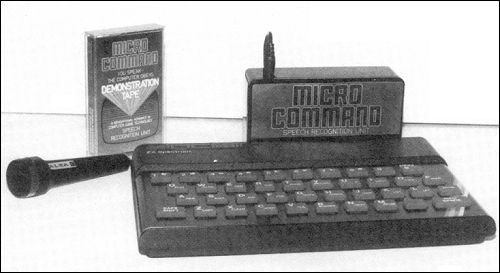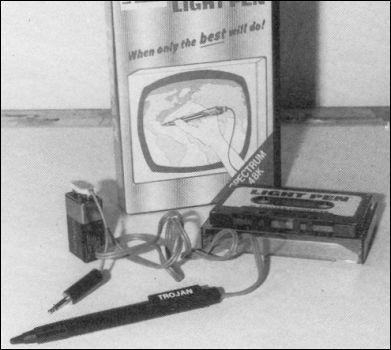| Hardware World |

SPEECH recognition is a growing area of interest and the new Micro Command from Orion Data looks set to help. It is supplied with a microphone and a demonstration tape which allows Spectrum users to teach their computers up to 15 words and then to have words recognised when repeated.
Users of 48K will also be able to play Sheeptalk, a game where the dog is controlled by spoken commands.
Normally, speech recognition for a computer is very expensive; a look inside Micro Command shows why. It contains a Z-80A CPU, as used in the Spectrum, ROM and RAM, buffers and audio circuitry.
The demonstration tape takes you through the process of learning to use the unit in easy stages. Starting with up and down and then adding left and right it allows you to continue only if you score more than 80 percent. You must pronounce each word very carefully. Once past that stage you can play Sheeptalk. The game, produced originally by Virgin Games, is in Basic and hence fairly slow. It shows the limitations of the unit, as it is difficult to keep the same careful tone when the dog starts driving the sheep into the river.
Included with Micro Command are comprehensive instructions for its use, plus an additional information booklet which lists the basic teaching program and a disassembly of the machine code which is used. It also gives details of the variables used by the code and shows how to include Micro Command in your programs.
Micro Command costs £49.95. That may seem expensive to Spectrum users but considering its contents, the work which must have gone into it, and the price of other similar units, it is reasonable. Orion Data is at Brighton, East Sussex.
THE ORIGINAL Pixel Pad, now marketed by Peter Blanford & Go, has been released again, with versions for the BBC, Spectrum and Commodore 64, along with a new Graphic Grids pack.
The Pixel Pad is the biggest pad available, being 43cm. x 29.5cm. overall. It has a full screen grid, 29cm. x 21.5cm. of 24 lines by 32 columns, each character square being sub-divided into 8x8. Both the character squares and the plot positions are marked. At the bottom of the pad are eight 8x8 grids marked from 1 to 128 for UDGs. At the side is a summary of all the commands you are likely to need.
The Graphic Grids are A5 size and have 16 8x8 grids and a 13x4 screen grid. The pads are aimed mainly at educational users but a 50-sheet Pixel Pad can be obtained from Peter Bamford & Co, London. It costs £4.95 plus £1 p&p. Graphic Grids are priced at £2.45. They are also available through the Spectrum chain of shops.
IF YOU often carry your Spectrum the S1 Computer Case by Treetop Designs could be useful. The case is a standard size, 480mm. x 380mm. x 110mm. executive briefcase with an ABS insert moulded to accept the computer, power supply, Sinclair printer and a cassette deck.
The moulding inclines the Spectrum to a comfortable working angle and includes a small panel which has a LOAD/SAVE switch and a re-set button. When in use the lid of the case can be removed.
The unit ensures that all the leads are out of sight and, when you upgrade your Spectrum by buying an Interface One and Microdrives, you can also obtain a new moulded insert - S2 - to house them.
Both versions of the case cost £47.95 with extra inserts at £15.45 and can be obtained from Treetop Designs, Kent.

TROJAN PRODUCTS specialises in making light pens for a range of computers, one being the 48K Spectrum. The pen is supplied with driving software on tape which allows you to draw pictures or to choose from a menu.
Once the software has loaded, the pen plugs into the EAR socket of the Spectrum. It takes its power from a PP3 battery which is also supplied. On-screen you are given the option of drawing or instructions. The instructions show you how to use the pen and also how to modify it if you want to use it in your programs as a menu chooser.
All that needs is about 20 lines of Basic and 200 bytes of machine code, both of which are given. When using it that way the code gives a number which corresponds to the line number to which the pen is pointing. In that way it is easy to choose from a list of options.
The drawing program has two movable points and by using them you can draw lines, circles and boxes, fill areas with colour or even draw free-hand. It takes time to grow accustomed to the last option. It is very good with horizontal lines but not so good at vertical ones -they tend to 'wiggle' slightly. Other options allow you to load and save pictures, change colours, insert characters or copy the screen to a Sinclair printer.
The pen worked well and was easy to use - overall a well-thought-out product. The only difficulty which might arise is that due to changes in the Spectrum, older versions of the pen might not work with the latest version of Issue 3s. Trojan will exchange software if you experience difficulties.
The pen is reasonably priced at £17.25 inc. VAT and p&p and is available direct from Trojan Products, Swansea or local computer shops.
EAST LONDON Robotics has improved its SP48 kit which upgrades Issue 2 and Issue 3 Spectrums from 16K to 48K. The new kit, SP48b, has been introduced because Issue 3 Spectrums need an additional link to be made on the PCB. The kit includes a small metal clip which solves that problem.
The instructions supplied with the kit are clear and straightforward, most useful being a photocopy of the inside of a Spectrum with the positions of the chips marked and also showing the way they go.
If care is taken, fitting the kit can be attempted by anyone, whether having electrical knowledge or not.
To test the kit fully we obtained a 16K Issue 3 Spectrum and fitted it and, as always seems to happen when a number of people are watching, it did not work. We telephoned the ELR panic number and the problem was easily pin-pointed and a replacement chip sent.
It should be pointed out that the error was not due to ELR but a mis-match between two of the chips.
The offending chip was swapped temporarily with one from another piece of equipment and both worked after the transplant.
Also included with the kit is a free software tape entitled Beyond Horizons. It is a very basic program giving a few pointers on how the Spectrum works.
The SP48b costs £23, the kit for Issue One Spectrums is £35 plus 65p p&p, and is available by mail order from East London Robotics Ltd, London.
A NEW joystick interface has been released by Rainbow Electronics. It has a built-in beep amplifier. The interface has one good point in that it can be programmed as a game is running. Other than that not much can be said for it.
To program it, you have to hold down a key, move the joystick, and then release the key. You must do that for each of the normal four positions, then again for the four positions while also holding the fire button and again if you want to move diagonally, a feat which would need at least three hands.
Once programmed, a switch on the front of the interface is moved to the play position; it disables the keyboard. Finally there is no volume control for the sound amplifier.
The interface is also poorly made. The 28-way edge connector normally has a plastic locating blank to line it up. In this case it is merely a blob of solder. The connector, and the joystick socket, are stood off from the interface PCB by about 1in.
The unused pins are left hanging. That is very unstable and could short out. There are also some resistors soldered in mid-air rather than via the PCB.
At £24 plus £1 p&p the interface is competitively priced but could not be recommended. Rainbow Electronics is at Witney, Oxfordshire.